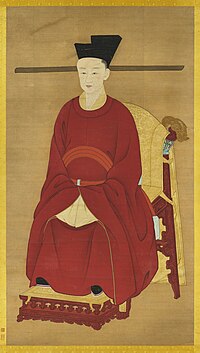Round collar robe
This article needs additional citations for verification. (February 2022) |

Round collar robe (團領, pinyin: tuán lǐng, Hangul: 단령 Danryeong or dallyeong) was clothing of ancient China, commonly known as Yuanlingshan, and it was later used by East Asian cultural sphere.[1] It is a round-collared outer garment which is long enough to cover the entire body.
History[]
China[]
The round collar robe started to appear during the Eastern Han dynasty in China.[2] It started as an under-garment, and later at the time of the Six dynasties that the round collared robe started to be worn as an outer robe and could be worn as a form of formal clothing.[3]
It is a formal attire which was typically worn by men although it also became fashionable for women to wear it in some dynasties, such as in the Tang dynasty.[1]
Korea[]
In Korea, the danryeong was introduced from Tang dynasty by Kim Chun-chu in the second year of Queen Jindeok's rule.[4] Since then, it has been worn as an official outfit for government officials until the end of Joseon.[4] It originated from the Chinese' round collar robe.[5] It is used used as Gwanbok.[4] It is worn together with the dapho.[4]
In late Joseon, under the 1884 decree of King Gojong, only black-coloured danryeong were permitted to be worn by court officials.[6]

Danryeong of Joseon Dynasty
References[]
- ^ a b Wang, Xinyi; Colbert, François; Legoux, Renaud (2020). "From Niche Interest to Fashion Trend: Hanfu Clothing as a Rising Industry in China". International Journal of Arts Management. 23 (1). Retrieved 1 February 2021.
- ^ Wang, Fang (2018). "Study on Structure and Craft of Traditional Costumes of Edge". Proceedings of the 2nd International Conference on Economics and Management, Education, Humanities and Social Sciences (EMEHSS 2018). Atlantis Press: 584–588. doi:10.2991/emehss-18.2018.118. ISBN 978-94-6252-476-7.
- ^ Yang, Shuran; Yue, Li; Wang, Xiaogang (2021-08-01). "Study on the structure and virtual model of "xiezhi" gown in Ming dynasty". Journal of Physics: Conference Series. 1986 (1): 012116. doi:10.1088/1742-6596/1986/1/012116. ISSN 1742-6588. S2CID 236985886.
- ^ a b c d Nam, Min-yi; Han, Myung-Sook (2000). "A Study on the Items and Shapes of Korean Shrouds". The International Journal of Costume Culture. 3 (2): 100–123.
- ^ Fashion, identity, and power in modern Asia. Kyunghee Pyun, Aida Yuen Wong. Cham, Switzerland: Springer. 2018. p. 116. ISBN 978-3-319-97199-5. OCLC 1059514121.
{{cite book}}: CS1 maint: others (link) - ^ Pyun, Kyunghee; Wong, Aida Yuen (2018). Fashion, identity, and power in modern Asia. Cham, Switzerland: Springer. ISBN 978-3-319-97199-5. OCLC 1059514121.
- History of Asian clothing
- Fashion stubs
